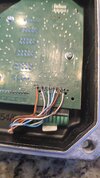cheapie408
New Member
I have a variable speed pump that does not have wifi and would like to add one.
Found a youtube video of someone taping into the buttons of the controller using a WiFi relay to mimic a button press. Is it safe to assume that most if not all buttons are some forum of dry contact?
The buttons are connected using a ribbon cable to the board in the photo below. There are a total of 7 buttons on the keypad and a total of 9 pins on the ribbon cable. I measure the current and it appears that it's operating on 5V.
I don't know much about electronics but I'm guessing the keypress should send 5v to whatever the trigger is?
What's the best way to figure out which buttons to press? Would I be measuring for continuity or voltage?


Found a youtube video of someone taping into the buttons of the controller using a WiFi relay to mimic a button press. Is it safe to assume that most if not all buttons are some forum of dry contact?
The buttons are connected using a ribbon cable to the board in the photo below. There are a total of 7 buttons on the keypad and a total of 9 pins on the ribbon cable. I measure the current and it appears that it's operating on 5V.
I don't know much about electronics but I'm guessing the keypress should send 5v to whatever the trigger is?
What's the best way to figure out which buttons to press? Would I be measuring for continuity or voltage?



Last edited:


